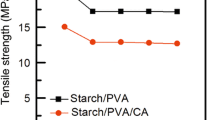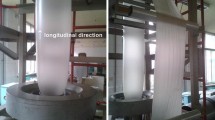Abstract
Starch granules were modified with trisodium trimetaphosphate (TSTP) and characterized by P31-NMR, FTIR and DSC. Seventy-micron films were prepared from modified starch and polycaprolactone blends by solvent casting technique. Three different types of films—PCL (100% polycaprolactone), MOD-ST/PCL (50% modified starch and 50% polycaprolactone blend) and NONMOD-ST/PCL (50% nonmodified starch and 50% polycaprolactone blends)—were prepared, and their thermal, mechanical, and morphologic properties were investigated to show the increased performance of PCL with the addition of starch and also the effect of modification. It was observed that with the addition of starch the Young's modulus of polycaprolactone was increased and became less ductile, whereas tensile strength and elongation at break values decreased. Biodegradation of these films was inspected under different aerobic environments with the presence of Pseudomonas putida, activated sludge, and compost. It was observed that whereas P. putida had almost no effect on degradation during 90 days, with the presence of activated sludge, considerable deformation of films was observed even in the first 7 days of degradation. In a compost environment, degradation was even faster, and all polymer films were broken into pieces within first 7 days of degradation and no film remained after 15 days.
Similar content being viewed by others
REFERENCES
CEN TC 261 SC4 W62 draft “Requirements for packaging recoverable in the form of composting and biodegradation, test scheme for the final acceptance of packaging,” March 11, 1996.
S. Lim and P. A. Seib (1993) Cereal Chem. 70, 137–144.
R. W. Kerr and F. C. Cleveland, Jr. (1959) U.S. Patent 2,884,413.
N. E. Lloyd (1970) U.S. Patent 3,539,551.
O. B. Wurzburg, W. Jarowenko, R. W. Rubens, and J. K. Patel. (1980) U.S. Patent 4,216,310.
D. Demirgöz, C. Elvira, J. F. Mano, A. M. Cunha, E. Piskin, and R. L. Reis (2000) Polym. Degrad. Stabil. 70, 161–170.
F. Lefebvre and C. David (1994) Polym. Degrad. Stabil. 45, 347–353.
A. C. Albertson, R. Renstad, B. Erlandsson, C. Eldsater, and S. Karlson (1998) J. Appl. Polym. Sci. 70, 61–74.
M. Rutkowska, A. Dereszewska, J. H. Jastrzebska, and H. Janik (1998) Macromol. Symp. 130, 199–204.
C. Eldsäter, B. Erlandsson, R. Renstad, A. C. Albertson, and S. Karlsson (2000) Polymer 41, 1297–1304.
S. Ponsart, J. Coudane, B. Saulnier, J. L. Morgart, and M. Vert (2001) Biomacromolecules 2, 373–377.
C. V. Benedict, J. A. Cameron, and S. J. Huang (1983) J. Appl. Polym. Sci. 28, 335–342.
K. Kasuya, K. Takagi, S. Ishiwatari, Y. Yoshida, and Y. Doi (1998) Polym. Degrad. Stabil. 59, 327–332.
M. Avella, M. E. Errico, P. Laurienzo, E. Martuscelli, M. Raimo, and R. Rimedio (2000) Polymer 41, 3875–3881.
W. P. Ye, F. S. Du, W. H. Jin, J. Y. Yang, and Y. Xu (1997) React. Funct. Polym. 32, 161–168.
ASTM D 5247–92 standard test method for determining the aerobic biodegradability of degradable plastics by specific microorganisms.
ASTM D 5271–92 standard test method for assessing the aerobic degradation of plastic materials in an activated-sludgewastewater-treatment system.
ASTM D 5209–92 standard test method for determining the aerobic biodegradation of plastic materials in the presence of municipal sewage sludge.
C. Babaç and H. Yavuz (2002) Master thesis, Hacettepe University Bioengineering Department, Ankara, Turkey, p. 66.
Manual of Methods for General Bacteriology, (1981) American Society for Microbiology, Washington, D.C., p, 499.
ASTM D 5338 D-92 standard test method for determining aerobic biodegradation of plastic materials under controlled composting conditions.
ASTM D 882–97 standard test method for tensile properties of thin plastic sheeting.
E. H. Nabeshima and M. V. E. Grossmann (2001) Carbohyd. Polym. 45, 347–353.
http://food.oregonstate.edu/starch/gelatinization.html.
E. Duquesne, D. Rutot, P. Degree, and P. Dubois (2001) Macromol. Symp. 175, 33–43.
R. Mani and M. Bhattacharya (2001) Eur. Polym. J. 37, 515–526.
M. F. Koenig and S. J. Huang (1995) Polymer 36, 1877–1882.
L. Averous, L. Moro, P. Dolo, and C. Fringant (2000) Polymer 41, 4157–4167.
H. Derradji-Serghat, G. Bureau, Y. Couturier, and J. C. Prudhomme (1999) Starch/Starke,51, 362–368.
H. Yavuz, C. Babac, K. Tuzlakoglu, and E. Piksin (2002) Polym. Degrad. Stabil. 75, 431–437.
Author information
Authors and Affiliations
Corresponding author
Rights and permissions
About this article
Cite this article
Yavuz, H., Babaç, C. Preparation and Biodegradation of Starch/Polycaprolactone Films. Journal of Polymers and the Environment 11, 107–113 (2003). https://doi.org/10.1023/A:1024635130991
Issue Date:
DOI: https://doi.org/10.1023/A:1024635130991




